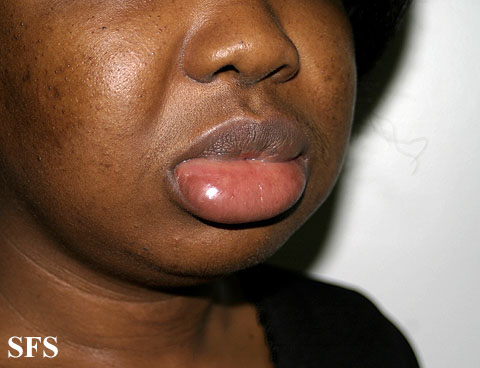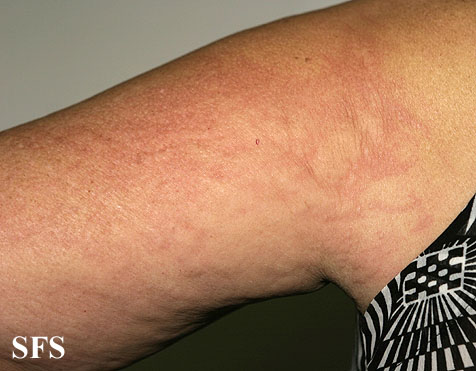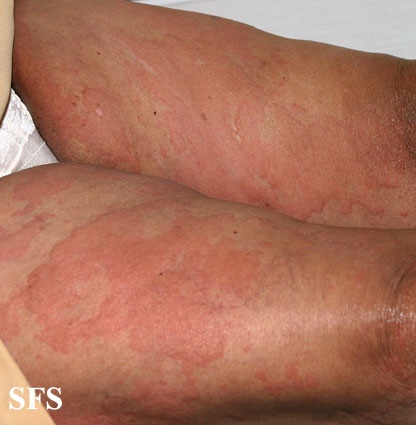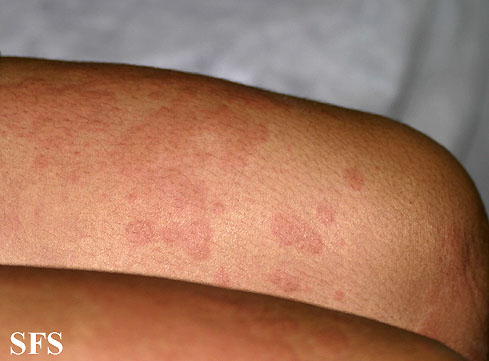Urticaria (Hives, Itchy Red Skin Welts) and Angioedema (Swelling)
What is urticaria?
Urticaria, commonly known as hives, is a condition where there is red, itchy swellings on the skin (wheals or welts) that appears and disappears often for no known reason. It can appear with large swelling just under the skin which is known as angioedema. Sometimes the swelling is of the airways and can lead to difficulty breathing, suffocation and even death. Urticaria may be acute or chronic depending on the duration of time that it exists. Sometimes it can come and go repeatedly in which case it is said to be episodic urticaria. The condition may affect 1 out of 6 people at least once in their lifetime but in most cases it is acute and never occurs again.
Urticaria Reasons
Urticaria occurs when certain chemicals that cause inflammation are released in large amounts for no obvious reason. These chemicals include histamine, bradykinin, kallikrein and other vasoactive substancs which are stored in certain immune cells in the skin known as mast cells and basophils. Normally these chemical are only released when necessary, like if the skin is injured or there is an infection. In urticaria, however, these chemicals are released when there is no threat to the body. Within minutes it causes more blood to flow through the skin and for fluid to leak out of blood vessels into the skin thereby causing swelling of the skin.
Immune and Non-Immune Triggers
Sometimes the immune system itself triggers this release of these chemicals and it is therefore said to be an immune-mediated activation. This type of reaction is seen with allergies and in anaphylactic shock. It can also occur with autoimmune diseases like lupus (systemic lupus erythematosus / SLE). When urticaria arises by some other trigger like drug usage, physical stimuli and psychological stress then it is known to be non-immune mediated activation.
Acute Urticaria
When urticaria lasts for less than 6 weeks then it is said to be acute urticaria. It tends to last for 24 to 48 hours in most people. This may even occur as a once off episode in life and may never occur again. Acute urticaria is more common than the chronic form. In most cases a trigger can be found such as certain drugs, foods, an infection or insect bite. This causes a type of allergic reaction known as type I hypersensitivity.
Chronic Urticaria
When urticaria lasts for more than 6 weeks then it is known as chronic urticaria. It can be persistent (continuous) or recurrent (comes and goes). Chronic urticaria is more likely with autoimmune diseases which are usually chronic conditions. It also arises for no known reason in the majority of cases (idiopathic urticaria) and the triggers are almost never identified.
What is Angioedema?
Angioedema is the swelling that occurs in the lower layers of the skin or the mucosal lining of cavities, often as a result of an allergic reaction. It may appear as deep welts on the skin or a swollen red area like when it affects the eyelids or lips. Angioedema is a result of ‘leaking’ from blood vessels which is a temporary effect caused by certain chemicals released from immune cells or the activation of vasoactive substances in the body. Not all causes of angioedema are due to an allergic reaction. A large percentage of angioedema cases are due to unknown causes (idiopathic angioedema).
Picture from Wikimedia Commons
Differences between Angioedema and Urticaria
The term angioedema is often used concurrently with urticaria or hives. While angioedema occurs in most cases of urticaria, these are two separate conditions.
- Angioedema occurs in the lower dermis (reticular dermis) and/or subcutaneous or submucosal tissues. Urticaria occurs in the upper dermis (papillary dermis).
- Angioedema can affect the mucosal linings of body cavities like the airways or intestines. Urticaria only occurs on the skin.
- Itching is very mild or absent in angioedema. In urticaria, itching is pronounced in most cases.
- Pain or tenderness may be present in angioedema. Pain and tenderness is usually absent in urticaria.
Urticaria Video
Urticaria Types
There are several different subtypes of urticaria that may be classified by the causes or triggers.
- Ordinary urticaria – acute or chronic
- Physical urticarias triggered by physical triggers like mechanical force, temperature, water and sun.
– Mechanical : delayed pressure urticaria, symptomatic dermographism, vibratory angio-oedema.
– Thermal : cold contact urticaria, localised heat urticaria, cholinergic urticaria.
– Water : aquagenic urticaria.
– Sun : solar urticaria.
– Physical activity : exercise-induced anaphylaxis. - Contact urticaria triggered by exposure to allergens (allergic) or chemicals (irritants).
- Autoinflammatory syndromes – hereditary (familial) or acquired in life
- Urticarial vasculitis
There are several other variants but those mentioned above are the more common subtypes.
Urticaria Causes
The causes behind urticaria is not always known although the disease process is fairly well understood. Some of the triggers includes :
- Heat or cold
- Pressure
- Vibration
- Contact with latex, animal hair, pollen, dust and other allergens similar to allergic contact dermatitis.
- Drugs like aspirin, NSAIDs, pain killers, certain antibiotics and ACE inhibitors.
- Injected substances
- Transfusions
- Exercise
- Emotional stress
- Water
- Sun
- Infections – viruses, bacteria and parasites.
- Foods, especially allergenic foods, like eggs, wheat, eggs, nuts, soy, fish and shellfish.
These triggers are more likely for acute urticaria. With regards to chronic urticaria, its triggers are largely unknown and it tends to occur with certain chronic disorders where the immune system attacks the body (autoimmune diseases). Some of the causes and triggers of chronic urticaria includes :
- Autoimmune diseases like systemic lupus erythematosus (SLE), Sjogren’s syndrome and autoimmune thyroiditis.
- Drugs like aspirin, NSAIDs, pain killers, certain antibiotics and ACE inhibitors.
- Cancers
- Endocrine disorders
- Idiopathic – unknown causes and triggers.
Urticaria Symptoms
Apart from skin symptoms, urticaria can also present with various other symptoms some of which can be very serious and potentially life threatening.
Hives Rash
The hives rash typically lasts for anywhere between 30 minutes to 36 hours. It may appear as :
- Red and swollen lesions.
- Lines (linear), round or rings (annular) or bow-shaped (arcuate).
- Patches separated by normal skin or coalesces into one large patch.
- Itchy and sometimes painful rash.
- Blanching with pressure.
Sometimes there may be dark patches and ulcers.
Hives Swelling
Angioedema is closely related to hives and may occur simultaneously with hives. It is mainly seen as swelling of the face, lips, tongue and/or larynx. Swelling of the lips and tongue can cause slurred speech and the tongue or larynx may be responsible for a change in the tone and volume of the voice. More seriously though, swelling of the airways can cause difficulty breathing and in severe cases this is potentially life threatening.
Picture of the angioedema of the lip from Dermatology Atlas courtesy of Samuel Freire da Silva, M.D.
Hives Other Symptoms
Various other symptoms may be present which are systemic meaning it involves different sites and systems throughout the body. These symptoms may be due to the underlying cause at times.
- Bone pain
- Fever
- Joint pain
- Joint swelling
- Swollen lymph nodes
- Weight changes
Urticaria Pictures
Urticaria photos from Dermatology Atlas courtesy of Samuel Freire da Silva, M.D.
Urticaria Diagnosis
Urticaria can be diagnosed upon taking a medical history and with a physical examination. No further testing is required. Testing is advised when other skin diseases need to be excluded or in chronic urticaria to identify any underlying diseases.
Differential Diagnosis
Urticaria may be confused with other skin conditions such as :
- Atopic dermatitis
- Allergic contact dermatitis
- Drug-hypersensitivity rash
- Erythema multiforme
- Pityriasis rosea
- Scabies
Urticaria tests
Some of the following tests may be helpful to identify the underlying cause of chronic urticaria in particular.
- Allergy tests
- Anti-nuclear factor (ANF)
- Complete blood count (CBC)
- Erythrocyte sedimentation rate (ESR)
- IgE – total and specific
- Liver function test
- Skin biopsy
- Thyroid profile
- Urea and electrolytes
Urticaria Treatment
Treatment should be focused more on identifying triggers of urticaria and avoiding it. Some preventative measures are given below for the more common triggers of urticaria. Using cool water to bathe the area and topical applications (creams or lotions) like menthol 1% may provide some relief. Oxygen may be administered as supportive treatment when there is airway narrowing with angioedema.
- Antihistamines to ease symptoms and should be taken regularly.
- Corticosteroids are rarely used but may be needed for short period during a severe episode of urticaria.
- Antileukotrienes may be effective when combined with antihistamines.
- Tricyclic antidepressants may be useful to relieve itching particularly in chronic urticaria.
- Epinephrine may be administered for angioedema particularly when it causes airway obstruction.
Urticaria Prevention
- Keep a food diary and try to identify trigger foods.
- Start an elimination diet to isolate possible foods that may be triggering urticaria.
- Wear lose clothing and appropriately sized underwear.
- Avoid becoming overheated or cold by dressing appropriately especially in environments with extremes of temperature.
- Limit time in the sun and water.
- Take note of acute medication that may trigger urticaria or speak to a doctor about the possibility of chronic medication triggering the condition.
References :











